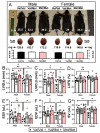Sex-Based Differences in Cardiac Gene Expression and Function in BDNF Val66Met Mice
- PMID: 34210092
- PMCID: PMC8269163
- DOI: 10.3390/ijms22137002
Sex-Based Differences in Cardiac Gene Expression and Function in BDNF Val66Met Mice
Abstract
Brain-derived neurotrophic factor (BDNF) is a pleiotropic neuronal growth and survival factor that is indispensable in the brain, as well as in multiple other tissues and organs, including the cardiovascular system. In approximately 30% of the general population, BDNF harbors a nonsynonymous single nucleotide polymorphism that may be associated with cardiometabolic disorders, coronary artery disease, and Duchenne muscular dystrophy cardiomyopathy. We recently showed that transgenic mice with the human BDNF rs6265 polymorphism (Val66Met) exhibit altered cardiac function, and that cardiomyocytes isolated from these mice are also less contractile. To identify the underlying mechanisms involved, we compared cardiac function by echocardiography and performed deep sequencing of RNA extracted from whole hearts of all three genotypes (Val/Val, Val/Met, and Met/Met) of both male and female Val66Met mice. We found female-specific cardiac alterations in both heterozygous and homozygous carriers, including increased systolic (26.8%, p = 0.047) and diastolic diameters (14.9%, p = 0.022), increased systolic (57.9%, p = 0.039) and diastolic volumes (32.7%, p = 0.026), and increased stroke volume (25.9%, p = 0.033), with preserved ejection fraction and fractional shortening. Both males and females exhibited lower heart rates, but this change was more pronounced in female mice than in males. Consistent with phenotypic observations, the gene encoding SERCA2 (Atp2a2) was reduced in homozygous Met/Met mice but more profoundly in females compared to males. Enriched functions in females with the Met allele included cardiac hypertrophy in response to stress, with down-regulation of the gene encoding titin (Tcap) and upregulation of BNP (Nppb), in line with altered cardiac functional parameters. Homozygous male mice on the other hand exhibited an inflammatory profile characterized by interferon-γ (IFN-γ)-mediated Th1 immune responses. These results provide evidence for sex-based differences in how the BDNF polymorphism modifies cardiac physiology, including female-specific alterations of cardiac-specific transcripts and male-specific activation of inflammatory targets.
Keywords: Duchenne muscular dystrophy; Val66Met; brain-derived neurotrophic growth factor; dilated cardiomyopathy; rs6265 polymorphism.
Conflict of interest statement
The authors have no conflicts of interest to disclose.
Figures





References
-
- Roebroek A.J.M., Schalken J.A., Bussemakers M.J.G., van Heerikhuizen H., Onnekink C., Debruyne F.M.J., Bloemers H.P.J., Van de Ven W.J.M. Characterization of human c-fes/fps reveals a new transcription unit (fur) in the immediately upstream region of the proto-oncogene. Mol. Biol. Rep. 1986;11:117–125. doi: 10.1007/BF00364823. - DOI - PubMed
-
- Mizoguchi H., Nakade J., Tachibana M., Ibi D., Someya E., Koike H., Kamei H., Nabeshima T., Itohara S., Takuma K., et al. Matrix Metalloproteinase-9 Contributes to Kindled Seizure Development in Pentylenetetrazole-Treated Mice by Converting Pro-BDNF to Mature BDNF in the Hippocampus. J. Neurosci. 2011;31:12963–12971. doi: 10.1523/JNEUROSCI.3118-11.2011. - DOI - PMC - PubMed
MeSH terms
Substances
Grants and funding
LinkOut - more resources
Full Text Sources
Molecular Biology Databases
Miscellaneous

